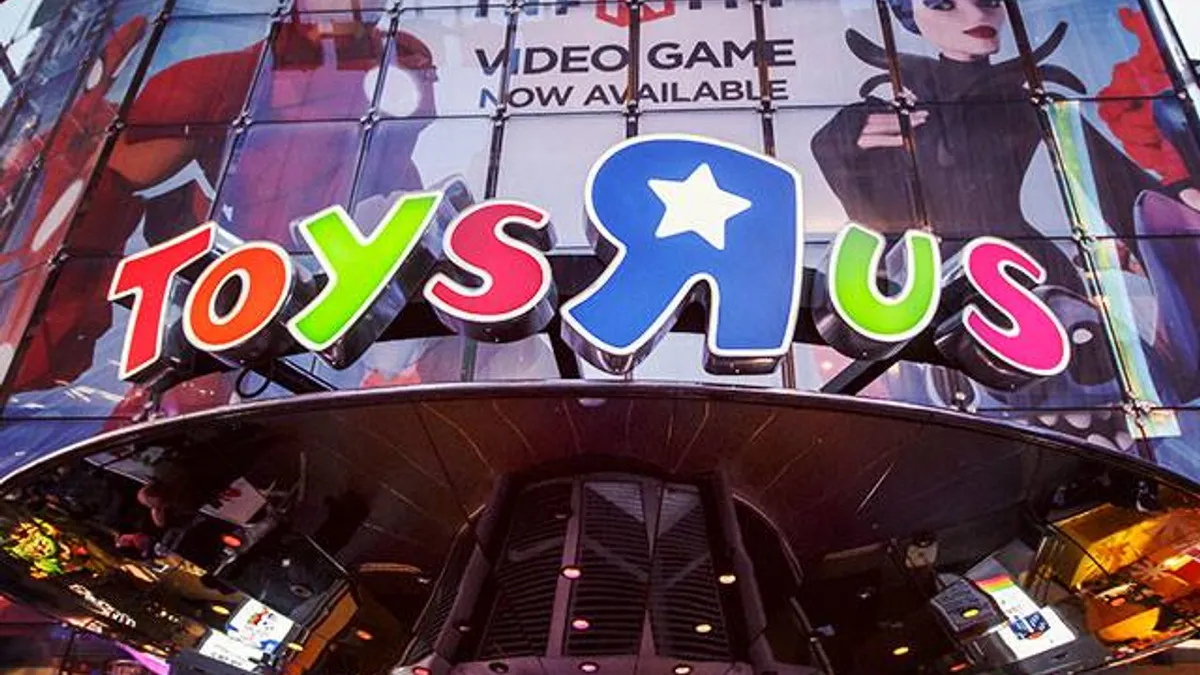Dive Brief:
- Toys R Us, which filed for bankruptcy last week, unveiled a new rebranding effort and media campaign on Thursday, centered on the concept of free play for kids. Tied to the rebranding are new play "labs" that the company is testing in 42 stores, where children can play with popular toys before purchasing.
- The toy retailer also announced this week that it was partnering with marketplace platform Mirakl to sell products online next year. The goal for Toys R Us is to "increase its product selection and decrease time to market for new merchandise," according to a press release.
- The online and branding efforts come as the retailer tries to shed debt in bankruptcy and fights for market share after losing it to mass merchants and online players for more than a decade. According to the Washington Post, some Toys R Us suppliers expect to take a loss for the year as a result of the retailer’s Chapter 11 filing. And some suppliers have severed ties to Toys R Us, the Post reported. A Toys R Us spokesperson did not immediately reply to Retail Dive’s request for comment.
Dive Insight:
Both the online partnership and re-branding are necessary steps for a toy retailer that has fallen behind other specialty retailers that have expanded and sharpened their online game and have worked to make the most out of their physical locations.
Toys R Us has taken small steps toward both in the past, but rather than investing in itself, the toy seller has been funneling $400 million in cash every year toward paying down its $5 billion debt load — the legacy of a leveraged buyout by private equity companies more than a decade ago.
According to a company spokesperson, the new branding campaign, dubbed "Today We Play," was developed in partnership with BBDO and led by Chief Marketing Officer Carla Hassan, who joined Toys R Us in February from PepsiCo. The campaign features a commercial directed by Shawn Levy (who directed the film "Night at the Museum" and the hit Netflix series "Stranger Things") that will be part of a national media campaign, according to the spokesperson.
The video and branding campaign centers on research and anxiety in some corners that children’s schedules have been too loaded with structured activities and events, like sports, that are organized and supervised by adults. With the rebranding, Toys R Us is trying to position its chain of 1,200 toys stores as a place for kids to experiment and play. In a blog post, the company said, "Our mission at Toys R Us is to set play free, and help kids everywhere, have the best childhood ever."
The toy labs, which will have dedicated space and staff, fall in line with what is rapidly becoming common wisdom — that brick-mortar-retailers need to capitalize on their potential to create and house "experiences" for customers, to give them a reason to come to stores rather than shop on Amazon.
Toys R Us has experimented with in-store stations and in-store events in the past, without much impact on overall sales. For now, the rollout is modest — the toy labs will be in less than 4% of the retailer’s stores. A spokesperson said the company is testing and studying the labs — which are given roughly 500 square feet inside the participating stores — before making decisions on an expansion.
In the long run, it will likely take Toys R Us a large investment to turnaround its business, and it might need to make much bigger existential decisions about its place in the toy-selling world.
"They're at risk of being caught in an increasingly shrinking center," Greg Portell, lead partner for consulting firm A.T. Kearney's retail practice, told Retail Dive in an interview before Toys R Us filed for bankruptcy. "On the one hand, there are online players that can be more convenient. There are high-end bespoke toy shops that are much more curated. Then you have essentially a big box toy company that is stuck with an undifferentiated position and a cost base that doesn't reflect that."
Meanwhile, the company is working through a Chapter 11 process that will hopefully reduce the company’s expenses and debt load. It has already secured $3.1 billion in bankruptcy financing to stay in business for the holidays, which is a positive sign that its lenders see a future in the brand.
But of course Toys R Us' relationship with suppliers is also key to the retailer’s long-term health. Some see Toys R Us as "too big to fail," considering its position as the last national pure-play toy chain. However, news that some suppliers are cutting shipments even as Toys R Us secures financing in bankruptcy is worrisome, given what it says about how vendors view the retailer.
As Linda Parry Murphy, chief executive of Product Launchers, a supplier that connects smaller toymakers with retailers, told the Washington Post, "We don’t want to have anything to do with them anymore — not online, not in stores, not at all. ... This is a crushing blow to startups."
Vendors of any size pulling back is also a problem in the here and now. If the world’s biggest toy chain can’t secure a given product, that's one less reason for consumers to shop at Toys R Us.
This story is part of our ongoing coverage of the 2017 holiday shopping season. You can browse our holiday page and sign up for our holiday newsletter for more stories.














